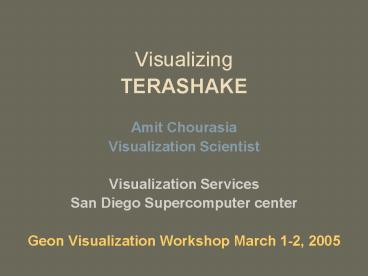Visualizing - PowerPoint PPT Presentation
1 / 22
Title:
Visualizing
Description:
Large Scale Earthquake Simulation on Southern San Andreas. 33 researchers, 8 Institutions. Southern California Earthquake Center. San Diego Supercomputer Center ... – PowerPoint PPT presentation
Number of Views:74
Avg rating:3.0/5.0
Title: Visualizing
1
- Visualizing
- TERASHAKE
- Amit Chourasia
- Visualization Scientist
- Visualization Services
- San Diego Supercomputer center
- Geon Visualization Workshop March 1-2, 2005
2
About Terashake
- Large Scale Earthquake Simulation on Southern San
Andreas - 33 researchers, 8 Institutions
- Southern California Earthquake Center
- San Diego Supercomputer Center
- Information Sciences Institute
- Institute of Geophysics and Planetary Physics
(UC) University of Southern California - San Diego State University
- University of California, Santa Barbara
- Carnegie-Mellon University
- ExxonMobil
Slide Courtesy Marcio Faerman
3
About Terashake
- Description of fault structure
- Description of velocity model (anelastic seismic
wave propagation speed through sediment basins
and through rock) - Validation of the anelastic seismic wave
propagation code - Description of the expected fault rupture
scenario - Greek!!!
Slide Courtesy Marcio Faerman
4
TeraShake Simulation Area
- Rectangular region parallel to San Andreas fault
containing - Los Angeles,
- San Diego,
- Mexicali,
- Tijuana,
- Ventura Basin,
- Fillmore,
- Southern San Joaquin Valley,
- Catalina Island,
- Ensenada
- 600 x 300 x 80 km
Slide Courtesy Marcio Faerman
5
TeraShake Earthquake Simulation
- Magnitude 7.7 earthquake on southern San Andreas
- Mesh of 1.8 Billion cubes, 200 m
- 0.011 sec time step, 20,000 time steps 3 minute
simulation - Kinematic source from Cajon Creek to Bombay Beach
- 75 sec source duration
- 18,886 point sources
- 240 processors on San Diego SuperComputer Center
DataStar - 20,000 CPU hours, over approximately 5 days
wall clock - 47 million megabytes of output
- Asynchronous rendering of simulation output
during ongoing computation
Slide Courtesy Marcio Faerman
6
Vista
- It is a multithreaded, platform independent,
scalable and robust volume renderer uses out of
core paging. Vista is built on Scalable
Visualization Toolkit (SVT)
7
What Vista can do?
- Volume Render any size volume using out of core
paging - Large Image resolutions - any resolution possible
- Create walk around
- data segments
- Handles 2D meshes
- IsoVoluming
- lt-gtIsoSurfacing
8
About Data
9
Go! Visualize
- Velocity components
- (Volumes and Surfaces)
10
Visualize ?what?
- Velocity within specific range
- Color ramps easily understood by scientists.
250.0 250.0
cm/s
11
Visualize ?what?
- Context Geographic location
- Context Fault lines
- Simulation Time
12
Visualize ?what?
- Velocity components and magnitudes
- Velocity Cumulative peaks
- Velocity range and color schema
13
One of the Surface Viz
- Movie Clip
14
One of the Volume Viz
- Movie Clip
15
Current Viz Effort
- Wave propagation in 3d
- Topography with wave propagation
- Movie Clip1 Movie Clip2
- Without 3d Terrain With 3d Terrain
16
Tools we use
- Vista (Scalable Visualization Toolkit SVT)
- Command line volume renderer (Works!)
- Mesh Viewer
- Interactive Volume renderer (Java based)
- Maya
- Adobe suite
- Other things that work
17
More Visualizations
- Visit website
- http//vistools.npaci.edu/
- See Software and Examples
- SCEC Visualizations
- http//vistools.npaci.edu/examples/scec.htm
18
Current Viz not enough ?Need more?what?
- Curl
- Divergence
- Directivity
- ?
- ??
- ???
19
Is 2d the ?limit?
- Ease in navigation/orientation by scientists?
- Ease of 3d perception on monitor?
- What are interest zones/regions?
- Analysis methods for 3d data?
- ???
- Are we ready for volumetric Visualization?
20
TeraShake2
- 16 large scale simulations
- 250 Tbytes
- 480 wave propagation simulations
- 2.5 Tbytes
- Integration between synthetic and observed data
- Inversion studies Frechet Kernel database
21
- Thanks for your patience!
22
- ? - ?































